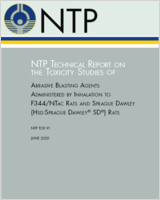This is a work of the US government and distributed under the terms of the Public Domain
NCBI Bookshelf. A service of the National Library of Medicine, National Institutes of Health.
National Toxicology Program. NTP Technical Report on the Toxicity Studies of Abrasive Blasting Agents Administered by Inhalation to F344/NTac Rats and Sprague Dawley (Hsd:Sprague Dawley® SD®) Rats: Toxicity Report 91 [Internet]. Research Triangle Park (NC): National Toxicology Program; 2020 Jun.

NTP Technical Report on the Toxicity Studies of Abrasive Blasting Agents Administered by Inhalation to F344/NTac Rats and Sprague Dawley (Hsd:Sprague Dawley® SD®) Rats: Toxicity Report 91 [Internet].
Show detailsAbrasive blasting, commonly known as sandblasting, involves forcibly projecting a stream of abrasive particles through compressed air or steam against a surface to change its quality or to remove contaminants. Blasting sand, most often used in abrasive blasting, contains high levels of crystalline silica, which can cause pulmonary fibrosis (silicosis) after exposure through inhalation and is considered a lung carcinogen. Alternatives to blasting sand with lower crystalline silica content exist, including specular hematite, which is mostly iron oxide (Fe2O3). Specular hematite has previously been shown to induce less lung injury, inflammation, and fibrosis in vivo than blasting sand.1 Other alternatives to blasting sand include coal slag, crushed glass, and garnet; however, no comprehensive chronic inhalation studies have been performed to evaluate the health effects, including pulmonary toxicity, of these alternative compounds. Testing data are needed due to the high production volume of these compounds, the number of exposed workers, and the inadequacy of available toxicity data to inform safe exposure levels.
In 1974, the National Institute for Occupational Safety and Health (NIOSH) recommended banning the use of silica sand (or other substances containing more than 1% free silica) as an abrasive blasting material, suggesting that less hazardous materials be used in blasting operations.2 NIOSH has recommended alternatives to silica sand,3 but they are based on the presence or absence of known hazards—such as respirable quartz, arsenic, beryllium, cadmium, lead, chromium, manganese, nickel, titanium, silver, and vanadium.4 They do not consider the potential risks of exposure to these specific blasting agents, as comprehensive evaluations have not been conducted and the health effects of chronic inhalation have not yet been studied. Without adequate testing and evaluation of alternatives, it is difficult to make explicit recommendations of less hazardous alternatives to silica sand.
To begin the process of obtaining health effects data on silica sand substitutes, NIOSH assessed acute pulmonary toxicity in rats following intratracheal instillation of nine commercially available substitutes.1,5 The blasting materials tested were coal slag, specular hematite, steel grit, copper slag, nickel slag, crushed glass, staurolite, garnet, and olivine. Of these nine, NIOSH nominated five substitutes (coal slag, crushed glass, garnet, specular hematite, and steel grit) for further testing to determine the potential for these agents to induce lung fibrosis after whole-body inhalation exposure (during which animals in their respective cages are placed into exposure chambers and exposed to test article [particulate] aerosols). Specular hematite is a relatively new alternative abrasive blasting material that appears to have low pulmonary toxicity potential, as reported in the study by Hubbs et al.,1 and confirmation of this might provide a basis for recommending it as an alternative to silica sand.
To address these data gaps, the National Toxicology Program (NTP) performed 2-week inhalation toxicity studies to compare blasting sand with the alternative abrasive blasting agents coal slag, crushed glass, garnet, and specular hematite. Pulmonary toxicity and tissue burden were assessed in male F344/NTac rats after inhalation (whole-body) exposure to target aerosol concentrations of 0, 3, 15, or 30 mg/m3 for blasting sand, coal slag, crushed glass, and garnet or 0, 3, 15, 30, or 60 mg/m3 for specular hematite. The objectives of the 2-week studies were to determine acute toxicity, identify target organs, evaluate lung and lymph node burdens, establish no-effect levels for pathological changes, if any, associated with 2 weeks of exposure, and provide the basis for the selection of test article and exposure concentrations to be used in subsequent 39-week studies.
The objectives of the 39-week inhalation toxicity studies were to compare blasting sand with specular hematite. Because specular hematite also exhibited low pulmonary toxicity in the 2-week study, pulmonary toxicity, as well as fibrogenicity, tissue (lung and lymph node) burden, and immunotoxicity, were assessed in male and female Sprague Dawley (Hsd:Sprague Dawley® SD®) rats after whole-body inhalation exposure to target aerosol concentrations of 0, 15, 30, or 60 mg/m3 blasting sand or specular hematite. Male rats were used for the core study, whereas female rats were used for the immunotoxicity study, although some of the immunotoxicity end points were also evaluated in the core male rats. Data generated from these studies will provide a framework upon which NIOSH can base recommendations for the use of alternatives to crystalline silica and could provide dose-response toxicity data to inform occupational exposure limit recommendations.
- Overview - NTP Technical Report on the Toxicity Studies of Abrasive Blasting Age...Overview - NTP Technical Report on the Toxicity Studies of Abrasive Blasting Agents Administered by Inhalation to F344/NTac Rats and Sprague Dawley (Hsd:Sprague Dawley® SD®) Rats
Your browsing activity is empty.
Activity recording is turned off.
See more...